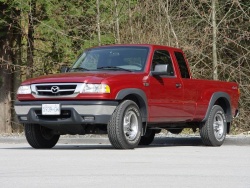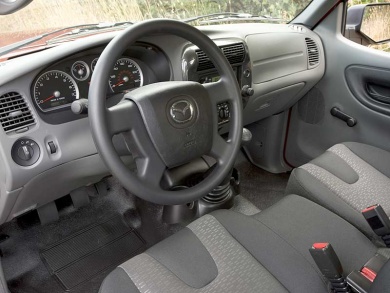 2009 Mazda B4000; photo by Greg Wilson. Click image to enlarge |
|
Related articles on Autos
Manufacturer’s web site
|
By Chris Chase
Find this vehicle in Autos’s Classified Ads
Sometimes, all you need is a little truck. Mazda knows this, which is why its B-Series pickup has been in production since 1972. It’s had ties to Ford’s small trucks since the beginning, but became a twin to the Ranger in all but its name in 1994. That relationship carried over to the fifth generation model, introduced in 1998.
It’s either a tribute to the design’s solidity or an admission by Ford that profits in this segment are as small as the trucks themselves that the current B-Series/Ranger has changed little in the 12 years since that 1998 redesign.
In that year, the B-Series was offered with a 2.5-litre four-cylinder engine (119 hp/146 lb.-ft. of torque), or a choice of 3.0-litre (150 hp/185 lb.-ft.) or 4.0-litre (160 hp/225 lb.-ft.) V6s; with the truck’s model names being based on engine displacement, the base version was the B2500, while the B3000 and B4000 were up-market options.
 Mazda B4000 Quad Cab 4X4; photo by Russell Purcell . Click image to enlarge |
In 2000, the 3.0-litre engine gained 10 hp and 16 lb.-ft. (for 155 and 201 each, total), and in 2001, the 4.0-litre engine got overhead camshafts, which boosted power output to 207 hp and 245 lb.-ft.
As with the Ranger, the four-cylinder disappeared in 2000 and 2001, to be replaced in 2002 with a smaller 2.3-litre motor making 143 hp and 154 lb.-ft. of torque.
A five-speed manual was standard with all three engines initially, with four-speed auto being the option in four-cylinder and 3.0-litre models, while 4.0-litre trucks got a five-speed auto as the upgrade.
Rear-wheel drive was the default with all three engines, and four-wheel drive was available with the larger V6.
By 2009, the 3.0-litre V6 was gone, and in 2010, all 4.0-litre models got four-wheel drive.
  Top: 2003 Mazda B4000 Quad Cab 4X4, by Russell Purcell; bottom: 2009 Mazda B-Series. Click image to enlarge |
The B-Series’ fuel consumption ratings were identical to those of the Ranger: in early models, ratings ranged from 10.7 L/100 km (city) and 8.0 L/100 km (highway) for a four-cylinder, manual transmission model, to 14.0 L/100 km (city) and 9.5 L/100 km (highway) for a version fitted with the 3.0-litre V6 and four-speed automatic. Figures for a 4.0-litre model with four-wheel drive were 15.5/11.2 L/100 km.
Despite the newer four-banger’s smaller displacement, it actually made more power than the old 2.5-litre. It also got more favourable fuel consumption ratings: 9.8 L/100 km (city) and 7.7 L/100 km (highway) with the manual transmission. With the four-cylinder engine, both the B-Series and the Ranger were regularly earned the title of most fuel-efficient new pickup trucks in Canada. By 2010, the B-Series’ fuel numbers were 9.5/7.3 L/100 km with the four-cylinder and manual transmission, and 15.1/11.2 for a V6 model with automatic transmission.
According to Consumer Reports, two-wheel drive models are the most reliable; they earn above-average ratings across the board, where four-wheel drive trucks are only average.
As CR’s data suggests, the primary things to look out for have to do with the four-wheel drive system. One common problem is a faulty four-wheel drive shift motor, an electric component that does the work of shifting the truck in and out of four-wheel drive when the driver uses the dashboard switch to activate the system. Here’s what to do in a pinch if it happens to your truck and here’s how to fix it more permanently.







 Follow Autos on Twitter
Follow Autos on Twitter



